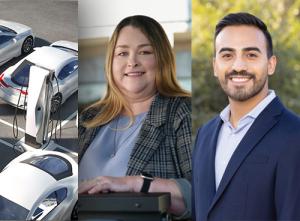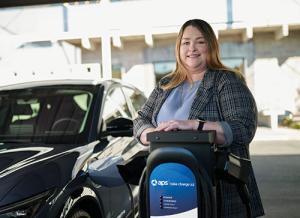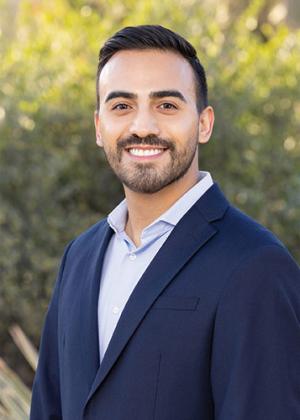EV Adoption
Kerri Carnes is Director, Customer to Grid Solutions at Arizona Public Service. Tony Perez is Program Consultant, Customer to Grid Solutions at at Arizona Public Service.
The Public Utilities Fortnightly team asked the same five broad questions of eighteen experts from twelve utilities. We found it so interesting to compare these dozen discussions, the commonalities, and the differences too. Read on to see what's up with EVs at Arizona Public Service, Avangrid, CMS Energy, Commonwealth Edison, Con Edison, Duquesne Light, Idaho Power, National Grid, NiSource, Portland General Electric, Puget Sound Energy, and Southern Company.

And we wish to express PUF's gratitude to Bidgely, the energy intelligence and EV solutions company, that sponsored this special feature, and made it possible for us to bring it to you.
PUF's Steve Mitnick: What are the goals of the electric vehicle programs at APS, both residential and commercial fleet?
Kerri Carnes: When it comes to our electric vehicle programs, we want to meet our customers where they are. Many are increasingly adopting EVs and we're taking a customer-centric approach to our utility program design.
 Kerri Carnes: Through our partnership with Chargeway, we’ve installed interactive information kiosks at dealerships that inform potential EV drivers of the costs of fueling on electricity in our service territory and special rebates on chargers. We worked with Salt River Project because our service territories are near one another in the Phoenix metro area.
Kerri Carnes: Through our partnership with Chargeway, we’ve installed interactive information kiosks at dealerships that inform potential EV drivers of the costs of fueling on electricity in our service territory and special rebates on chargers. We worked with Salt River Project because our service territories are near one another in the Phoenix metro area.
We want to be thoughtful and deliberate about program design and rates to make it simple for customers who choose to embrace the transition. I've challenged our team over the last couple of years to think about what our customers want and need from us.
We're working hard to ensure we are being proactive and incorporating their voice throughout the product development life cycle. When we develop programs at APS in the Customer to Grid Solutions organization, we engage with our customers before we launch then we go back and survey customers.
Sometimes everything is working great. Other times, customers give feedback, which we learn from and adjust. We make iterations so the programs, products, and services we offer meet the needs of our customers.
PUF: It's indicative of your job that you have other aspects of customer touchpoints.
 Tony Perez: As an energy company, we can’t do this alone. No one can do it alone. It’s a fundamental shift in how people move, and we’re providing electricity that’s moving people.
Tony Perez: As an energy company, we can’t do this alone. No one can do it alone. It’s a fundamental shift in how people move, and we’re providing electricity that’s moving people.
Kerri Carnes: That's the beauty of the way our team is structured. We don't live in just the transmission and distribution or the customer experience space.
We are the bridge between what our customers want and what the grid needs to reliably serve our customers. Our team has a deep operational understanding of what it means to supply reliable, affordable energy to all customers, while also helping customers understand their options when choosing to transition to EVs.
PUF: Tony, do you want to add anything about the goals of the program and its customer centricity?
Tony Perez: We're participating in the AZ Statewide Transportation Electrification Plan, which we developed in coordination with Tucson Electric Power, and we're preparing Arizona for more EVs on our state's roads.
For Arizona Public Service, our target is by 2030 to support the adoption of four hundred fifty thousand light-duty EVs in our service territory. We're working with various stakeholders to meet that goal through education and outreach, supporting fleet electrification, educating our customers, and deploying programs to help enable this transition.
For example, we've partnered with municipalities in our service territory to host free Ride-and-Drive events where customers can test drive an EV and ask EV drivers questions.
Additionally, APS's transportation fleet electrification goal is to transition thirty percent of all light-duty vehicles and equipment to electric by 2025, with a stretch goal to be one hundred percent carbon-free by 2050.
PUF: Are there rebates and incentives? How are you encouraging customers to consider adoption?
Kerri Carnes: We believe a robust education program and rebate structure are key to making it simple for drivers to embrace the transition and in ways that best meet their lifestyles. In Arizona and throughout our various service territories, we're dependent on our cars because areas are not walkable. Making sure we have adequate education and decision support tools has been an important and strategic focus for us.
Through our partnership with Chargeway, we've installed interactive information kiosks at select dealerships that inform potential EV drivers of the costs of fueling on electricity in our service territory and special rebates on chargers. We worked closely with Salt River Project on this program because our service territories are near one another in the greater Phoenix metro area.
This partnership stretches the reach of those beacons because our customers don't only shop for cars in our service territory. It's a unique way to verify educational opportunities for customers no matter where they're shopping for cars.
Customers view us as a trusted energy advisor, so they frequently start at aps.com to get information on programs. We've partnered with J.D. Power to launch an online EV tool, APS Cars Marketplace, which allows our customers to compare vehicles and connect them to incentives and rebates.
We have a rebate available for smart chargers in customers' homes. APS customers can find qualifying Level 2 chargers on APS Marketplace and receive a two hundred fifty-dollar rebate when purchasing.
Additionally, we have a program called SmartCharge, which is a way to gather customers' charging behavior information and learn whether they are charging in our service territory or in a neighboring service territory. It allows us to design better products, services, and rate offerings for our customers.
PUF: There are all kinds of automatic metering, data analysis, artificial intelligence, are you doing some of that too?
Tony Perez: Yes, there are more tools and services offered that rely on artificial intelligence. We are starting to use some of these cool new tools to understand the scale at which adoption is occurring within our service territory, which will be critical for APS to know as we plan to meet future demand.
PUF: APS has rates that can vary in time. How does that come together with electric vehicle charging?
Kerri Carnes: APS has a strong time variant rate program. APS customers on a time-of-use rate plan can charge their vehicle during off-peak hours when energy costs are lowest and when solar power is abundant.
With charging data, we were curious to see how frequently our customers were charging during peak hours. With the SmartCharge program, we were encouraged to see in the early data that about ninety percent of EV charging was occurring during off-peak hours.
This means that the time-of-use rate signal is working for early EV adopters in our service territory. We'll continue monitoring over time because it's reasonable to assume that an early EV adopter is already an active energy manager and is familiar with the time-of-use rate.
As adoption increases over time, it'll be crucial to understand how charging patterns evolve. What we are seeing, at least in the early parts of that data gathering, is that the time-of-use rates are a great signal to incentivize customers to charge during the middle of the day or after the on-peak period.
Tony Perez: We can't overstate the importance of education to our customers with this technology. It underpins everything we do.
We're seeing that in the past, the folks who have adopted EVs tend to be more technologically inclined, but new demographics are being introduced to this technology, and it's even more important that we are there to help them understand and answer important questions.
Question such as, what does it mean to have an electric vehicle in your home? What is the impact on your bill? Are you on the right price plan, or are there programs to help make it easier for you to interact with your EV and charge at home? These are all going to continue to evolve as we work with our customers.
PUF: Talk about working with external groups, maybe even NGOs.
Kerri Carnes: We spend a great deal of time focusing on partnerships and collaboration. It's important to engage in those conversations. In addition to the statewide transportation electrification plan, we've also established our transportation electrification collaborative, which we hold quarterly with stakeholders and NGOs.
It's important for us to facilitate those conversations and talk about what they're seeing and wanting from us as an energy company, and for us to share our perspective, as well.
Tony engages with the communities we serve. He's attended and coordinated ride and drives across our service territory and attends multiple industry forums.
We're committed to engaging with various stakeholders, whether it's our regulators, an NGO, a customer or municipality that we serve. It's important to make sure we're dedicating time for meaningful engagement because this will have a real impact on utilities at mass adoption.
To the extent possible, we don't want to be reactive. It's better from a planning and investment perspective to know what's coming and to plan accordingly.
Tony also partners across APS and collaborates with our Transmission and Distribution and Customer Experience partners on what trends and forecasts we're seeing. We want to make sure we're sharing that with our business unit partners so we're all planning appropriately.
PUF: Tony, there're about five hundred vendors and consultants, so you probably get calls every five minutes.
Tony Perez: The electric vehicle space is evolving quickly. It's important for us to access new solutions that would help our customers.
As an energy company, we can't do this alone. No one can do it alone. It's a fundamental shift in how people move, and we're providing electricity that's moving people.
We're great at serving customers that have buildings or houses, so stationary loads. Now, it's new technology that is changing how customers may interact with us.
We want to understand what their needs are, what they care about and how we can collaborate with other companies that we haven't historically worked with to ensure that the customer experience continues to be a positive one. Our primary goal is delivering reliable power.
That's what customers expect from us, and that's what we intend to do throughout this transition. But it's still important that we collaborate with charging station operators, auto manufacturers, and research companies to understand how technology is changing and how we can anticipate those changes in how we interact with our customers as they adopt the technology.
PUF: Where's this program going to be in say, three, four years from now?
Tony Perez: In that timeframe, I hope we'll be in a place where there is an affordable option for EVs for every customer, and that utilities have the right programs in place with the opportunity to interact with customers regardless of the electric vehicle or charging station in their home. It's an all-inclusive environment regarding EV adoption.
Kerri Carnes: I think the next few years is when things should be changing quite a bit. That's when a lot more EVs will be on the road, with all of the significant commitments that the auto manufacturers have been making over the last couple years.
We're seeing more available models, and pricing coming down so they're more accessible in our state. Neighboring states have adopted EV policies at a statewide level that we anticipate is going to make the secondary market strong in Arizona in the next few years.
EV adoption in the second half of this decade is going to look a lot different than it looks today.
It's making sure we've laid the foundation to arm our customers with the information they need to make good choices, including the best time to charge their vehicle. For instance, the middle of the day may be the best time to charge when there's an abundance of solar power on the system so customers can save on charging their vehicles and support a reliable grid.
We have to make a concerted effort to share information to customers in ways that they can absorb and incorporate into their lives because what will work for some, may not work for all. It's not necessarily a one size fits all, rather, thinking about how our customers live and work.
They are going to be reliant on their EVs, and we have to have programs to match those needs. We're excited about the second half of the decade and what the future looks like.
EV Leaders conversations at fortnightly.com:
- Arizona Public Service's Kerri Carnes and Tony Perez
- Avangrid's Scott Bochenek and Charles Spence
- CMS Energy's Lauren Snyder and Jeff Myrom
- Commonwealth Edison's Diana Sharpe
- Con Edison's Britt Reichborn-Kjennerud
- Duquesne Light's Brian Guzek
- Idaho Power's Billie McWinn and Patti Best
- National Grid's Melissa Lavinson
- NiSource's Fred Gomos
- Portland General Electric's Larry Bekkedahl
- Puget Sound Energy's Josh Jacobs and Malcolm McCulloch
- Southern Company's Lincoln Wood and Stephanie Gossman



